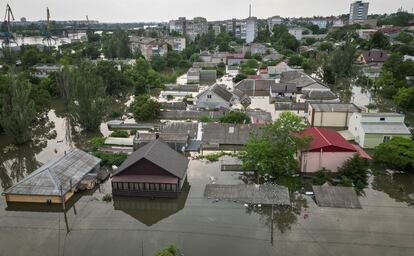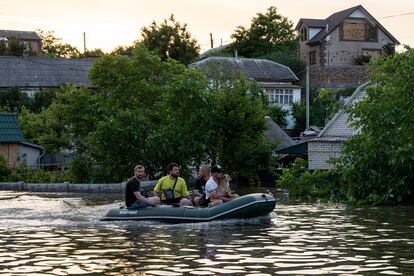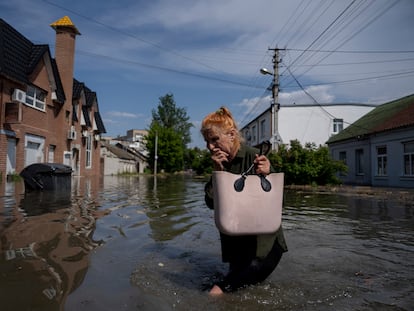EU not ruling out that Russia may commit acts similar to Nova Kakhovka dam destruction
An internal document from the foreign service points to Moscow as the probable perpetrator and gauges the effects of an ‘unprecedented’ catastrophe

The European Union points to Russia as the “very probable” perpetrator of Tuesday’s attack against the Nova Kakhovka dam on the Dnipro River, in southern Ukraine, which has caused an unprecedented humanitarian and environmental disaster. “Although at this moment the exact person responsible for the destruction of the dam cannot be identified,” says an internal document from the EU Foreign Service (EEAS), “it is most likely a reaction by Russia as part of its defensive measures against the Ukrainian counteroffensive.” The document, which EL PAÍS has seen, warns: “In light of the ongoing Ukrainian counteroffensive operations, we cannot rule out that Russia may commit similar acts in other parts of Ukraine.”
On Tuesday, the EU High Representative for Foreign Affairs and Security Policy, Josep Borrell, and the president of the European Commission, Ursula von der Leyen, focused on Russia when they condemned in the strongest terms the destruction of the Nova Kakhovka dam, considered an ecocide for its environmental damage, but also a war crime: attacks on civilian infrastructure are considered as such by international law. Now, the EU foreign service is analyzing the effects of one of the most serious environmental disasters in recent European history.

Water from the dam is flooding areas downstream of the Dnipro, forcing the evacuation of some 16,000 people from the right bank, under Ukrainian control, the EU document says. In addition, there are other areas where the situation can soon become untenable, as residents are left without drinking water and essential supplies. Ukrainian authorities have estimated at around 42,000 the number of people on both sides of the Dnipro, which flows between Kyiv-controlled territory and Russia-occupied territory.
“More than 80 settlements, including parts of the city of Kherson, are threatened with flooding,” says the EEAS document, which adds that, despite the fact that the dam also serves to cool the nearby Zaporizhzhia nuclear power plant, currently under Russian control, at the moment there is no risk as the plant’s reactors are all turned off.
The flooding is also causing massive environmental damage, notes the internal EU situation analysis document, “including the displacement of a large part of the mines that had been placed on the river banks, in particular by Russia, to defend itself from a Ukrainian counter-offensive. The EU warns that the entire flooded area will be contaminated with explosive munitions and affected by displaced mines, which will “significantly” affect rescue, humanitarian and return operations once the water recedes.
Explosion in the engine room

The EU describes the “unprecedented” attack that destroyed the Nova Kakhovka dam and points out that it was an explosion in the engine room that completely collapsed the dam. “The flooding [caused by the destruction of the dam] will prevent any military movement downstream of the dam, significantly reducing the front line (by about 200 km) and allowing Russia to use its forces in other areas,” reads the EU internal document.
The destruction of the dam will not prevent the Ukrainian counteroffensive, which was focused on the other side of the southern flank and aiming at places like Berdyansk to try to break up the corridor that, through occupied land, Russia has created between the peninsula of Crimea (occupied since 2014) and the areas of Donbas that it also maintains under its control. However, the dam disaster does divert resources and efforts.
The destruction of the Nova Kakhovka dam and its consequences may also intensify the global food crisis. In addition to the thousands of hectares of flooded farmland, about 94% of irrigation systems in the Kherson region, 74% in Zaporizhzhia and 30% in the Dnipropetrovsk region already have no water source, according to data provided by the Ministry of Agrarian Policy and Food of Ukraine.
Sign up for our weekly newsletter to get more English-language news coverage from EL PAÍS USA Edition
Tu suscripción se está usando en otro dispositivo
¿Quieres añadir otro usuario a tu suscripción?
Si continúas leyendo en este dispositivo, no se podrá leer en el otro.
FlechaTu suscripción se está usando en otro dispositivo y solo puedes acceder a EL PAÍS desde un dispositivo a la vez.
Si quieres compartir tu cuenta, cambia tu suscripción a la modalidad Premium, así podrás añadir otro usuario. Cada uno accederá con su propia cuenta de email, lo que os permitirá personalizar vuestra experiencia en EL PAÍS.
¿Tienes una suscripción de empresa? Accede aquí para contratar más cuentas.
En el caso de no saber quién está usando tu cuenta, te recomendamos cambiar tu contraseña aquí.
Si decides continuar compartiendo tu cuenta, este mensaje se mostrará en tu dispositivo y en el de la otra persona que está usando tu cuenta de forma indefinida, afectando a tu experiencia de lectura. Puedes consultar aquí los términos y condiciones de la suscripción digital.
More information
Archived In
Últimas noticias
Maduro pleads not guilty before the federal court in New York: ‘I am still the president of Venezuela’
A new test can detect Alzheimer’s from a finger prick
UN team enters Sudanese city of El Fasher after paramilitary massacre: ‘It’s like a ghost town’
A recipe for resistance: Indigenous peoples politicize their struggles from the kitchen
Most viewed
- Gilles Lipovetsky: ‘If you want to live better and fall in love, take Prozac, don’t look to philosophy’
- Alain Aspect, Nobel laureate in physics: ‘Einstein was so smart that he would have had to recognize quantum entanglement’
- Alvin Hellerstein, a 92-year-old judge appointed by Bill Clinton, to preside over Maduro’s trial in New York
- Maduro’s downfall puts China’s relationship with Venezuela to the test
- Why oil has been at the center of Venezuela-US conflicts for decades










































